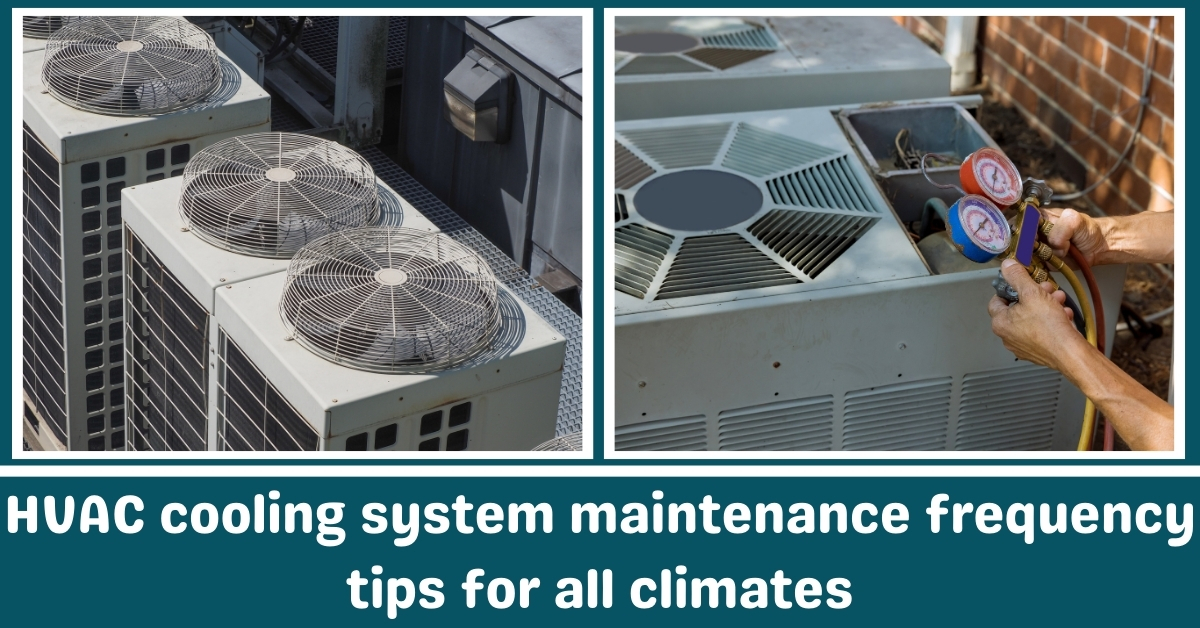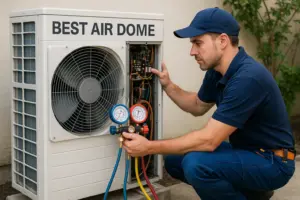HVAC cooling system maintenance is one of the most overlooked yet essential tasks for homeowners and building managers alike.
Many people assume that once their air conditioner is installed, it will continue to run smoothly year after year but the reality is quite different.
Without regular upkeep, even the best systems lose efficiency, rack up higher energy bills, and face unexpected breakdowns when you need them most.
Studies show that a neglected HVAC cooling system can consume up to 30% more energy than a well-maintained one. That’s money out of your pocket every month and potential stress during peak summer heat.
What’s more, different climates create different challenges for your system: dust storms in desert areas, salty air in coastal regions, or high humidity that encourages mold growth.
Understanding how often to inspect, clean, and service your HVAC cooling system based on your specific climate is key to long-term performance and comfort.
HVAC cooling system maintenance frequency tips for all climates
In this guide, we will explain practical, climate-specific maintenance frequency tips you can use to keep your system running reliably year after year.

1. Why HVAC Cooling System Maintenance Matters
Your HVAC cooling system isn’t a set-it-and-forget-it appliance. It’s a network of moving parts compressors, fans, coils, filters, thermostats, electrical wiring, and ductwork all working together to keep your space cool.
If any part of this network underperforms, the entire system struggles. When maintenance is neglected, airflow drops, parts wear out faster, and energy bills creep higher every month.
A clogged filter alone can cut airflow by up to 20%, forcing the system to work harder for the same result. According to the U.S. Department of Energy, regular HVAC maintenance can reduce your system’s energy use by 5% to 40%. It’s not just about lower costs either.
Routine inspections catch small issues like refrigerant leaks or loose electrical connections before they turn into emergency calls during peak summer.
Also, regular tune-ups keep your home’s air quality better, since a dirty or moldy system can circulate contaminants.
Simply put, an HVAC cooling system that is ignored will eventually fail earlier than it should, costing you more in repairs or total replacement.
Good maintenance keeps you comfortable, saves you money, and extends the lifespan of your equipment.
2. Basic HVAC Maintenance Tasks Everyone Should Know
No matter where you live, there are basic tasks you should do yourself to keep your HVAC cooling system running properly. The first is replacing or cleaning air filters.
For most homes, this should be done every 1 to 3 months, but in dusty or humid areas, you might need to do it monthly. Dirty filters restrict airflow, which reduces efficiency and strains the blower motor.
Next, clear debris from around the outdoor condenser unit. Leaves, branches, or dirt can block airflow. Keep at least two feet clear on all sides of the unit.
Also, visually inspect the refrigerant lines for leaks or insulation damage. Inside, check that your thermostat works correctly.
Test your system at the start of each cooling season to make sure it turns on and off properly and reaches the set temperature.
You should also keep the condensate drain line clear so moisture drains away and doesn’t back up into your system. A clogged drain can cause water damage and mold.
Some moving parts like fan motors and bearings may need lubrication once a year, but this is often best done by a professional.
Finally, check the electrical connections if you see worn wires or smell burning, call a technician right away. These basic tasks are simple but powerful.
They prevent small issues from growing and help your system run smoothly during the months you need it most.
3. Maintenance Tips by Climate Type
Where you live has a big effect on how often you should do these tasks and when you should schedule professional service. For hot and humid climates like Florida or Southeast Asia, the main enemy is excess moisture.
High humidity means condensation, which can lead to mold growth in ducts or coils. Filters should be checked monthly, because humidity helps dust stick to filters faster.
Clean coils at least every three months during heavy use. Check the drain line monthly, too, since mold or algae can block it. A professional inspection twice a year once before peak cooling season and once after is ideal.
For hot and dry climates like Arizona or the Middle East, dust and sand are constant problems. Filters should be checked every month, or even every two weeks during sandstorm season.
The outdoor condenser should be cleared of debris and rinsed off every couple of months. Coils should be cleaned twice a year.
Refrigerant levels should be checked at least once during the season. For temperate climates with warm summers and cold winters, like much of Europe or the northern U.S., cooling systems see seasonal use. Replace filters every two to three months during the summer.
Do a full system check before you switch it on for the season and clean the coils once during that time. For cold climates where cooling systems are used only occasionally, like Canada or Scandinavia, change filters before and after the season.
Cover the outdoor unit during the winter to protect it from snow and ice. Run a quick system test at the start of summer to check for problems.
For coastal climates with salty air and high humidity, like the Gulf Coast or the Pacific Northwest, corrosion is a big risk.
Filters should be checked every one to two months, coils rinsed monthly, and the condenser unit inspected for rust every few months. A full tune-up every spring will keep the system from wearing out early due to salt exposure.
4. Signs You’re Not Maintaining Enough
Many people wait until something breaks before they call for help, but by then the damage is done. Look for early warning signs that your HVAC cooling system is overdue for maintenance. Uneven cooling in your home often means airflow is restricted or refrigerant levels are low.
Rising electricity bills without any change in usage can signal the system is working harder than it should. Strange noises grinding, squealing, or rattling point to loose or failing parts that need fixing before they break completely.
A musty smell when the air conditioner is on could mean mold is growing inside your system or ducts. If you notice water pooling around the indoor unit, the condensate drain is probably clogged.
Frost on the refrigerant lines is another red flag. If you see any of these signs, don’t put it off. Small problems cost far less to fix than a full compressor replacement or an emergency call during a heatwave.
Keeping an eye on these warning signs helps you stay ahead of costly breakdowns.
5. DIY vs Professional HVAC Maintenance
It’s smart to know which tasks you can safely handle yourself and which require a licensed technician. Do-it-yourself maintenance includes changing filters, clearing debris, rinsing the outdoor unit, testing the thermostat, and keeping the area around the condenser clean.
You can also pour a cup of diluted bleach into the condensate drain line once in a while to prevent mold.
Anything that involves refrigerant, deep coil cleaning, electrical tests, or part replacements should be done by a qualified professional. Handling refrigerants without certification can be dangerous and is restricted by law in many places.
A good professional tune-up includes checking refrigerant levels, testing the system’s airflow, measuring the temperature difference across the coils, inspecting the electrical connections, lubricating moving parts, and verifying the system cycles on and off properly.
Think of it like servicing your car: you can top off washer fluid and check tire pressure, but you trust a mechanic for the brakes and engine.
An annual or twice-yearly professional inspection is worth the money because it catches problems early and keeps your system under warranty.
6. HVAC Maintenance Scheduling Checklist
Staying on top of HVAC maintenance is easier when you have a simple checklist and a clear schedule. Here’s an easy breakdown: For filters, mark your calendar every month during peak season.
If you live in a dry, dusty place, check every two weeks. For the outdoor condenser, inspect and clear debris at the start of every month. Rinse coils gently with a hose every few months if you see dirt buildup.
Inspect the thermostat settings at the start of each season to make sure they’re accurate. Check the drain line for clogs monthly in humid climates, or every few months elsewhere.
Plan professional service at least once a year preferably in spring before summer heat kicks in. If you live in extreme heat or near the ocean, twice-yearly tune-ups are a smart investment.
Keep a record of maintenance tasks, repairs, and technician visits. This helps track recurring issues and makes warranty claims easier.
A clear schedule saves you from forgetting key tasks that could otherwise lead to bigger problems later.
7. How Maintenance Extends HVAC System Life
Routine maintenance directly impacts how long your HVAC cooling system lasts. Systems that get annual check-ups can run well for 15 to 20 years, depending on usage and climate.
Without maintenance, you might be replacing your unit in just 10 to 12 years. Keeping filters clean and coils clear reduces strain on the compressor and fans, which are some of the most expensive parts to fix or replace.
Proper refrigerant levels mean the system doesn’t overwork to reach your thermostat setting. Well-maintained systems also maintain good indoor air quality by keeping mold and dust out of the air you breathe.
By catching leaks, loose connections, or worn parts early, you avoid surprise breakdowns that can lead to bigger repairs or total system failure.
All of this saves you money in both energy bills and replacement costs over time. Think of maintenance as insurance for your system a small cost that protects a much larger investment.
8. Proactive Tips for Long-Term HVAC Efficiency
Beyond regular check-ups, a few extra habits can keep your HVAC cooling system efficient and reliable for years. Use a programmable thermostat to avoid running the system when you’re not home.
This can cut energy costs by up to 10%. Keep blinds or curtains closed during the hottest part of the day to reduce the cooling load.
Install ceiling fans to help circulate cooled air, which means your system runs less often. Check that vents and registers aren’t blocked by furniture or drapes.
Make sure your home is properly insulated so cool air stays inside. If you live in a dusty or coastal area, consider adding extra air filtration or anti-corrosion coatings to protect your system.
If your unit is more than 15 years old and needs frequent repairs, replacing it with a modern, high-efficiency model can cut energy use by up to 40%.
Small steps like these, combined with consistent maintenance, make your HVAC cooling system more resilient and cost-effective in any climate.
Conclusion
Keeping your HVAC cooling system in good shape is not complicated, but it does require consistency.
Whether you live in a dry desert, a humid coastal area, or a region with mild seasons, a clear maintenance plan helps you avoid breakdowns and costly energy waste.
Changing filters on time, clearing debris, checking coils, inspecting drain lines, and scheduling regular professional tune-ups all add up to better performance and longer system life.
Small tasks done regularly prevent major problems later. They also help you spot early warning signs like odd noises, weak airflow, or unexpected spikes in your energy bills.
When you maintain your system properly, you enjoy more comfortable indoor temperatures, cleaner air, and lower utility costs.
You also protect one of your home’s biggest investments from premature failure. Make it a habit to follow your climate-specific checklist and set reminders on your calendar so nothing gets overlooked.
Taking these simple steps means your HVAC cooling system will keep you cool and comfortable for years to come.




